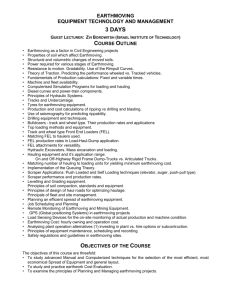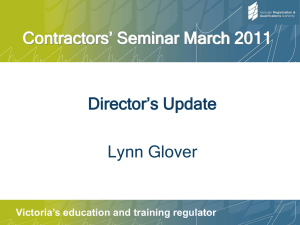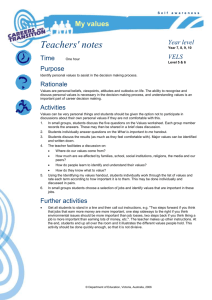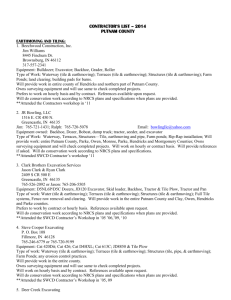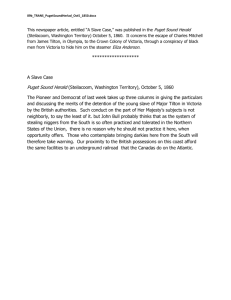Course in Basic Earthmoving * 22266VIC
advertisement
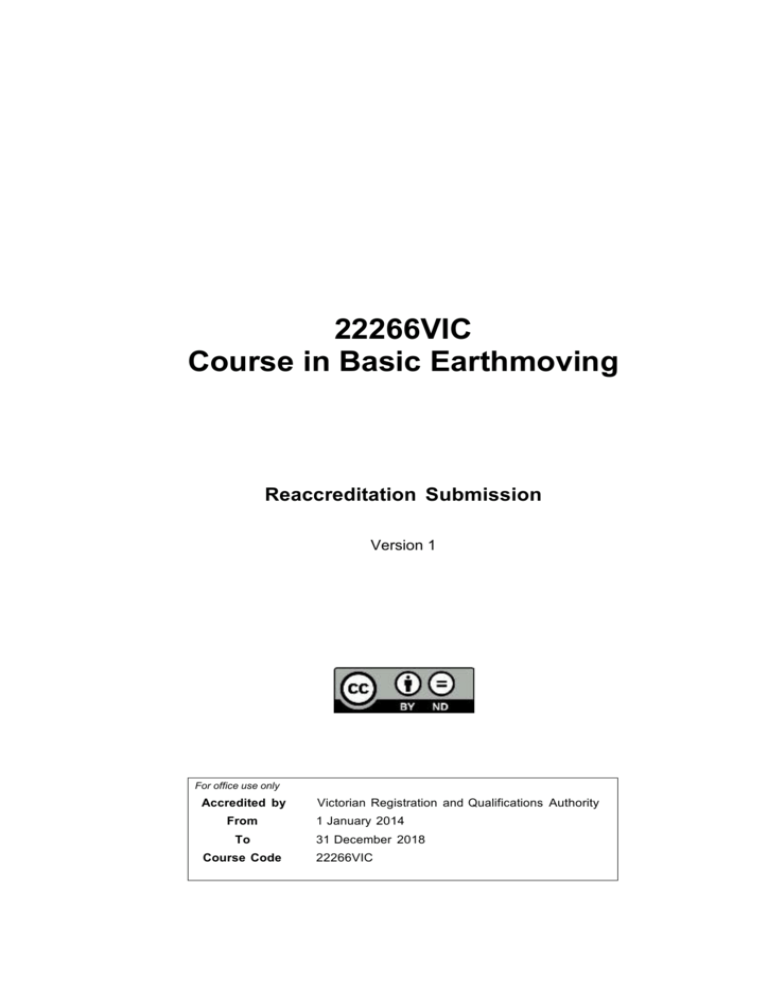
22266VIC Course in Basic Earthmoving Reaccreditation Submission Version 1 For office use only Accredited by From To Course Code Victorian Registration and Qualifications Authority 1 January 2014 31 December 2018 22266VIC © State of Victoria (Department of Education and Early Childhood Development) 2013. Copyright of this material is reserved to the Crown in the right of the State of Victoria. This work is licensed under a Creative Commons Attribution-NoDerivs 3.0 Australia licence (http://creativecommons.org/licenses/by-nd/3.0/au/). You are free use, copy and distribute to anyone in its original form as long as you attribute Higher Education and Skills Group, Department of Education and Early Childhood Development the author, and you license any derivative work you make available under the same licence. Disclaimer In compiling the information contained in and accessed through this resource, the Department of Education and Early Childhood Development (DEECD) has used its best endeavours to ensure that the information is correct and current at the time of publication but takes no responsibility for any error, omission or defect therein. To the extent permitted by law DEECD, its employees, agents and consultants exclude all liability for any loss or damage (including indirect, special or consequential loss or damage) arising from the use of, or reliance on the information contained herein, whether caused or not by any negligent act or omission. If any law prohibits the exclusion of such liability, DEECD limits its liability to the extent permitted by law, for the resupply of the information. Third party sites This resource may contain links to third party websites and resources. DEECD is not responsible for the condition or content of these sites or resources as they are not under its control. Third party material linked from this resource is subject to the copyright conditions of the third party. Users will need to consult the copyright notice of the third party sites for conditions of usage. Contents 22266VIC Course in Basic Earthmoving Version 1 © State of Victoria 2014 I Contents Section A: Copyright and course classification information .........................................1 1. Copyright owner of the course ...................................................................................... 1 2. Address......................................................................................................................... 1 3. Type of submission ....................................................................................................... 1 4. Copyright acknowledgement ........................................................................................ 1 5. Licensing and franchise ................................................................................................ 2 6. Course accrediting body ............................................................................................... 2 7. AVETMISS information ................................................................................................. 2 8. Period of accreditation .................................................................................................. 2 Section B: Course information......................................................................................3 1. Nomenclature ............................................................................................................... 3 2. Vocational or educational outcomes of the course ....................................................... 3 3. Development of the course ........................................................................................... 3 4. Course outcomes.......................................................................................................... 8 5. Course rules ................................................................................................................. 8 6. Assessment ................................................................................................................ 10 7. Delivery ....................................................................................................................... 12 8. Pathways and articulation ........................................................................................... 15 9. Ongoing monitoring and evaluation ............................................................................ 15 Section C: Units of competency .................................................................................16 Contents 22266VIC Course in Basic Earthmoving Version 1 © State of Victoria 2014 I Section A: Copyright and course classification information Section A: Copyright and course classification information 1. Copyright owner of the course Copyright of this course is held by the Department of Education and Early Childhood Development, Victoria © State of Victoria 2014 2. Address Department of Education and Early Childhood Development (DEECD) Executive Director Training Participation and Facilitation Division GPO Box 266 MELBOURNE VIC 3001 Day-to-day contact Edward Rush Curriculum Maintenance Manager Building Industries Holmesglen Institute PO Box 42 HOLMESGLEN VIC 3148 Telephone: Facsimile: Email: (03) 9564 1987 (03) 9564 1538 edward.rush@holmesglen.edu.au 3. Type of submission The course is submitted for reaccreditation. It replaces and has equivalent outcomes to 21768VIC Course in Basic Earthmoving. 4. Copyright acknowledgement Copyright of this material is reserved to the Crown in the right of the State of Victoria. © State of Victoria (Department of Education and Early Childhood Development) 2014. This document may be reproduced in whole or in part for study or training purposes, subject to the inclusion of an acknowledgement of the source. This work is licensed under a Creative Commons Attribution-NoDerivs 3.0 Australia licence (http://creativecommons.org/licenses/by-nd/3.0/au/). Section A: Copyright and course classification information 5. Licensing and franchise This work is licensed under a Creative Commons Attribution-NoDerivs 3.0 Australia licence (http://creativecommons.org/licenses/by-nd/3.0/au/). You are free to use, copy and distribute to anyone in its original form as long as you attribute the, Department of Education and Early Childhood Development as the author, and you license any derivative work you make available under the same licence. Copies of this publication can be downloaded free of charge from the Training Support Network website (http://trainingsupport.skills.vic.gov.au). 6. Course accrediting body Victorian Registration and Qualifications Authority (VRQA) GPO Box 2317 MELBOURNE VIC 3001 Telephone: Email: Website: 7. 8. (03) 9651 2806 vrqa@edumail.vic.gov.au www.vrqa.vic.gov.au AVETMISS information Period of accreditation ANZSCO code (Australian and New Zealand Standard Classification of Occupations) Earthmoving plant operator (general) 721211 ASCED code – 4 digit (Field of Education) 0309 Civil Engineering National course code To be provided by the VRQA following accreditation 1 January 2014 – 31 December 2018 22266VIC Course in Basicin Earthmoving Version Version 1 22266VIC Course Basic Earthmoving 1 © State © of State Victoria 2014 2014 of Victoria Page 2 of 24 1 of 24 Page Section B: Course information Section B: Course information 1. 2. Nomenclature Standard 1 AQTF Standards for Accredited Courses 1.1 Name of the qualification 22266VIC Course in Basic Earthmoving 1.2 Nominal duration of the course 80 hours Vocational or educational outcomes of the course Standard 1 AQTF Standards for Accredited Courses The 22266VIC Course in Basic Earthmoving provides an accredited training program and vocational outcomes for a person wishing to gain the skills and knowledge required to safely and efficiently perform basic operations on up to four types of earthmoving equipment. This course does not align with any specific AQF level. On completion of the 22266VIC Course in Basic Earthmoving, participants will have the skills and knowledge to: • • • • 3. Development of the course plan and safely prepare for earthmoving work tasks conduct checks before operating machinery safely and efficiently operate earthmoving machinery safely shut down machinery and secure the worksite. Standards 1 and 2 AQTF Standards for Accredited Courses Background information Earthmoving plant operators assist with the building of roads, rail, water supply, dams, treatment plants and agricultural earthworks. The operation of the machinery specified in this course is classified as ‘high risk construction work’ in Section 5.1.3 (p) of the Victorian Occupational Health and Safety Regulations 2007. Nevertheless, there are no occupational licenses required for the operation of earthmoving equipment in Victoria at the time of the development of the curriculum. During stakeholder consultation for this reaccreditation, it was found that work in the heavy and civil engineering construction sector continues to be dangerous. This is the sector in which earthmoving equipment operators are employed. According to WorkSafe Victoria statistics, 871 workers’ compensation claims were lodged in these occupations in 2011/2012, a 28% increase from the 624 claims lodged in 2002/2003 (claim lodgements in the building construction sector declined by 4.5% during the same period). Source: WorkSafe Victoria (2013, p 13). Statistics. Retrieved from http://www.worksafe.vic.gov.au/ data/assets/pdf_file/0017/43352/ Statistical-Summary-2011-12.pdf on 24 September, 2013 22266VIC Course in Basic Earthmoving Version 1 © State of Victoria 2014 Page 3 of 24 Section B: Course information 3.1 Industry/ enterprise/ community needs Support for the course is derived mainly from recognition by industry that the operation of earthmoving plant is dangerous and that workers in the industry must have opportunities to receive training in the safe use of the machinery. 22266VIC provides industry with the opportunity to ensure their workers receive the skills and knowledge they need to safely and effectively operate at a basic level, up to four of the most common types of earthmoving machinery found on Victorian civil construction sites. Furthermore, by enrolling their workers in the course, employers are able to show that they are attempting to meet the general requirement in Section 21(2)(e) of the Victorian Occupational Health and Safety Act 2004. This states that employers have a duty to ‘provide such information, instruction, training or supervision to employees of the employer as is necessary to enable those persons to perform the work in a way that is safe and without risks to health.’ WorkSafe Victoria has advised that successful completion of the course by an employee may contribute to the provision of satisfactory evidence on the part of the employer that they have met some of the conditions of this section of the Act. Support also comes from the course’s capacity to efficiently and effectively provide basic employment skills to some of the most vulnerable members of the community, namely the longterm unemployed and people who have been working in the industry for a period of time without any formal training in the safe operation of dangerous equipment. Target groups and demand for the course The broad scope of the course means it is attractive to the long-term unemployed, new entrants to the industry, and those who are currently employed but have no formal qualifications in the operation of earthmoving equipment. Graduates from the first category of the target market can use their Statement of Attainment to gain entry-level employment on small to large civil construction sites. After they have acquired some experience they can then apply to undertake more specialised training in national Training Package units and qualifications. The second and third mentioned groups tend to be placed in the course by their employers for the occupational health and safety (OHS) regulatory reasons mentioned previously. Demand for the course has been variable over the past few years with softening in demand evident recently. This decline has made it difficult to predict future take-up. Anecdotal evidence from the three training providers in Victoria suggests an enrolment in 2012/2013 of more than 200. 22266VIC Course in Basic Earthmoving Version 1 © State of Victoria 2014 Page 4 of 24 Section B: Course information The statistics from the Higher Education Skills Group (HESG) suggests a lower overall enrolment, as follows: 2009 2010 2011 2012 497 307 377 186 Summary of the skills and knowledge outcomes A project Steering Committee to oversee the development of the course was established. Under the guidance of the Steering Committee, consultation and validation processes were implemented to confirm the applicability of the current course outcomes and to identify future skills and knowledge requirements. Consultation for the reaccreditation involved the following: • A review of required skills and knowledge involving trainers and industry representatives during the first Steering Committee meeting on 5 August 2013. This took place in the form of a workshop to identify future trends in the industry and ensure these trends would be reflected in the new curriculum. Training Package units were also reviewed to consider their suitability as a replacement for the proposed course – none were identified. The details of the required skills and knowledge were also shared online using a ‘cloud’ collaboration tool to encourage further distribution and engagement by trainers and industry stakeholders. • A second round of consultation on the revised unit of competency. • A range of site visits, meetings and phone interviews with teachers and industry stakeholders. A WorkSafe Victoria representative was invited to join the Steering Committee but declined because earthmoving is an unlicensed occupation and does not fall within its authority. Steering Committee meeting dates were: • 5 August 2013 • 30 August 2013. A third meeting was not required because Steering Committee members agreed to sign off on the course via email. 22266VIC Course in Basic Earthmoving Version 1 © State of Victoria 2014 Page 5 of 24 Section B: Course information Mapping to existing Training Packages Mapping of existing Training Package content has been undertaken and it has been found that this qualification: • does not duplicate, by title or coverage, the outcomes of an endorsed Training Package qualification • is not a subset of a single Training Package qualification that could be recognised through one or more Statements of Attainment or a skill set • does not include units of competency additional to those in a Training Package qualification that could be recognised through Statements of Attainment in addition to the qualification • does not comprise units that duplicate units of competency of a Training Package qualification. The Industry Skills Council for drilling, mining, quarrying, and civil infrastructure, SkillsDMC, has also confirmed that they will not be developing a qualification, which provides coverage for 22266VIC in the foreseeable future. The curriculum reaccreditation process took place under the guidance of the following Steering Committee: • Mr Rod Garrard, Civil Contractors Federation • Mr Ted Henderson, Australian Easy Train • Ms Athena Jeanes, Australian Easy Train • Ms Sonia Grotaers-Close, VicRoads • Mr Michael Rose, VicRoads • Mr Liam O’Hearn, Construction, Forestry, Mining and Energy Union • Mr John Merlo, William Adams CAT • Mr Richard Beard, The Caterpillar Institute • Mr Peter Asling-Hough, Northern Melbourne Institute of TAFE In attendance was Mr Edward Rush, Curriculum Maintenance Manager Building Industries. 22266VIC Course in Basic Earthmoving Version 1 © State of Victoria 2014 Page 6 of 24 Section B: Course information 3.2 Review for reaccreditation Revisions are based on input from the Steering Committee. The need for the course had become less apparent in recent years because of the largely unregulated nature of the earthmoving industry in Victoria. However, through consultation, it was felt that a short course that provides a basic introduction to the safe operation of earthmoving machinery, which has the capacity to cause serious injury or death, continued to be important. The main areas identified for improvement to the course included: • The acronym WHS (from the national model Work Health and Safety Act) was addended to each instance of the acronym OHS. Victoria and Western Australia at the time of writing this course were the only jurisdictions not to have adopted the new model legislation, with Victoria at the time electing to maintain the 2004 Occupational Health and Safety Act. By adding the term WHS, the curriculum is ‘future proofed’ against changes in this aspect of the regulatory environment. • Deletion of the requirement that National Assessment Instruments be used as part of the unit assessment strategy. • WorkSafe Victoria at the time of the preparation of this course required anyone other than owner builders who did work at their domestic premises to obtain a Statement of Attainment in CPCCOHS1001A Work safely in the construction industry, otherwise known as a Construction Induction Card (CIC). As the purpose of the course is to quickly prepare graduates to safely do entry-level work on a range of construction sites, completion of the CIC has been included as an entry requirement to 22266VIC Course in Basic Earthmoving. It is noted that the previous iteration of the course, 21768VIC, which was reaccredited in 2006, did not include this prerequisite. However, it is further noted that WorkSafe Victoria did not introduce the CIC requirement until 2008, two years after the reaccreditation of 21768VIC. 22266VIC Course in Basic Earthmoving replaces and is equivalent to 21768VIC Course in Basic Earthmoving. All new students will be required to be enrolled in the new course from 1 January 2014. 22266VIC Course in Basic Earthmoving Version 1 © State of Victoria 2014 Page 7 of 24 Section B: Course information 4. 5. Course outcomes Standards 1 and 2 AQTF Standards for Accredited Courses 4.1 Qualification level Because this is a short course, the 22266VIC Course in Basic Earthmoving is not aligned to the Australian Qualifications Framework. 4.2 Employability skills Not applicable 4.3 Recognition given to the course (if applicable) Not applicable 4.4 Licensing/ regulatory requirements (if applicable) Not applicable Course rules Standards 2, 6, 7 and 9 AQTF Standards for Accredited Courses 5.1 Course structure To be awarded a statement of attainment for the 22266VIC Course in Basic Earthmoving, participants must successfully complete the single unit of competency. All students will undertake the unit of competency, VU21580 Operate earthmoving equipment safely, including the specific skills and knowledge required for the specific items of equipment they have selected. Unit of competency/ module code Field of Education code (six-digit) Unit of competency/module title Prerequisite Nominal hours VU21580 030717 Operate earthmoving equipment safely Nil 80 5.2 Entry requirements Participants enrolling in the 22266VIC Course in Basic Earthmoving must have attained the Construction Induction Card (CIC) by satisfactorily completing the unit CPCCOHS1001A Work safely in the construction industry. This addresses the requirement for all people performing construction work to provide proof of having completed a general OHS construction induction for the industry. 22266VIC Course in Basic Earthmoving Version 1 © State of Victoria 2014 Page 8 of 24 Section B: Course information Participants should also have literacy and numeracy competencies equivalent to Australian Core Skills Framework (ACSF) Level 2. This level of skill is exemplified by engaging with simple texts in familiar and predictable contexts. This is appropriate given the entry-level nature of the course. An individual competent at Level 2 of the ACSF will be able to demonstrate the following: • Reading Uses a number of reading strategies to identify and interpret relevant information within familiar text types. In the workplace this means the worker is able to understand directions on how to operate a piece of machinery safely. • Writing Conveys intended meaning on familiar topics for a limited range of purposes and audiences. In the workplace this means the worker will be able to write a brief systems-related text that uses an established format (for example, a brief shift report or an OHS incident report on a standard workplace form/proforma). • Oral communication Uses everyday language to provide information or maintain a conversation in familiar spoken contexts. In the workplace this means the worker can: – listen to short, explicit instructions for new work procedures and ask questions to clarify – explain routine procedures to others, eg workplace safety procedures or fire drills – report a problem/hazard/fault/defect to a supervisor or utility company – follow directions to perform a sequence of routine tasks, eg uses machinery/equipment such as forklift, or makes pre-operational checks on machinery/plant equipment. • Numeracy Identifies and comprehends relevant mathematical information in familiar activities or texts. In the workplace this means the worker can measure familiar and predictable quantities using simple and routine measuring instruments and units, or identify and name common uses of shapes in a familiar environment, eg shapes used for road or OHS/WHS danger signs. The worker should also be able to perform basic calculations. Participants are not required to have a current driver’s licence. 22266VIC Course in Basic Earthmoving Version 1 © State of Victoria 2014 Page 9 of 24 Section B: Course information 6. Assessment Standards 10 and 12 AQTF Standards for Accredited Courses 6.1 Assessment strategy All assessment will be consistent with Standard 1.2 of the Australian Quality Training Framework Essential Conditions and Standards for Continuing (or Initial) Registration. See: AQTF User Guides to the Essential Conditions and Standards for Continuing (or Initial) Registration – (http://www.training.com.au/documents/AQTF Essential Conditions and Standards for Continuing Registration.pdf). Consistent with Standard 1, Element 5 of the Australian Quality Training Framework Essential Conditions and Standards for Continuing (or Initial) Registration, RTOs must ensure that Recognition of Prior Learning (RPL) is offered to all applicants in determining competency for credit. The following principles should be used as a guide to the assessment approach: • Assessment tasks/activities should be grounded in a relevant context and not be culturally biased. • Participants should be assessed across a wide range of tasks integrated into practice, in order to increase reliability and validity of assessment. One-off assessment tasks do not provide a reliable and valid measure of competence. • Instructions for assessment tasks should be clear, explicit and ordered. Participants must know what is expected of them and the criteria by which they will be judged. • Time allowed to complete a task should be reasonable and specified and should allow for preparation and re-drafting as appropriate to the task. • Assessment should be validated. Moderation is likely to be a critical tool in validation. A range of validation strategies should be used, for example, mentoring, client satisfaction surveys, peer review and co-assessments. • Appropriate reference materials should be available to participants during assessment, eg personal word lists, dictionaries, thesaurus, calculators. 22266VIC Course in Basic Earthmoving Version 1 © State of Victoria 2014 Page 10 of 24 Section B: Course information Assessment tools must meet the rules of evidence. To meet the rules, evidence must be: • valid, eg, address the elements and performance criteria, reflect the skills and knowledge described in the unit of competency, show application in the context described in the Range Statement • current, eg, demonstrate the candidate's current skills and knowledge • sufficient, eg, demonstrate competence over a period of time, demonstrate repeatable competence, not inflate the language, literacy and numeracy requirements beyond those required in performing the task and • authentic, ie the work of the participant is corroborated/verified. Assessment methods and collection of evidence will involve application of knowledge and skills to civil construction workplaces or simulated environments. All assessment activities will be related to a civil construction context and must address the requirements of the Critical Aspects of Evidence section of the unit. A range of assessment methods will be used, such as: • observation of tasks in real or simulated work conditions, with questioning to confirm knowledge of earthmoving procedures • direct questioning. The evidence collected must relate to a number of performances assessed at different points in time, and, in a learning and assessment pathway, these must be separated by further learning and practice. Assessment must be consistent with the conditions and method of assessment specified in the unit. Simulated work must reflect actual workplace conditions and practices. 6.2 Assessor competencies Assessor competencies for this course must be consistent with the requirements of Standard 1, Element 1.4 of the AQTF: Essential Conditions and Standards for Continuing Registration. There are no additional assessor competencies for this course apart from those that meet the requirements of approved national standards for the registration of training organisations. 22266VIC Course in Basic Earthmoving Version 1 © State of Victoria 2014 Page 11 of 24 Section B: Course information The standards for registration normally require that trainers and assessors: • have the training and assessment competencies determined by the National Skills Standards Council (NSSC) or its successors, • have the relevant vocational competencies at least to the level being delivered or assessed, and • continue to develop their vocational and training and assessment competencies to support continuous improvements in the delivery of RTO services. In addition to the above, assessors must have comprehensive and current knowledge of the industry and the job or role against which performance is being assessed. Assessors should also have appropriate interpersonal and communication skills. Alternatively, a panel, team or partnership approach involving assessors and technical experts may be adopted whereby the assessment is conducted by a team/panel/partnership in which at least one assessor has the competencies determined by the NSSC and the other assessor(s) have the relevant vocational competencies, at least to the level being assessed. 7. Delivery Standards 11 and 12 AQTF Standards for Accredited Courses 7.1 Delivery modes There are no restrictions on offering the program on either a full-time or part-time basis. There is no mandatory workplace delivery, however, if offered in a simulated mode then participants should be exposed to real-work environments and examples/case studies. Strategies should be selected to reflect the nature of the elements and performance criteria and the needs of the participants. Some areas of content may be common to more than one element and therefore integration may be appropriate. The course aims to develop practical competencies within an industry setting. Practical demonstrations and opportunity for application are considered to provide the most suitable strategy to reflect the objectives of the course and the background to its development. An emphasis on OHS/WHS and environmental considerations must be integrated and reinforced at all times. 22266VIC Course in Basic Earthmoving Version 1 © State of Victoria 2014 Page 12 of 24 Section B: Course information Delivery of the unit of competency will take into consideration the individual needs of participants and may involve a blended delivery mode including: • workshops • individual assignments • team-based assignments • applied learning in the workplace or simulated civil construction environment. Participants may be supported through: 7.2 Resources • online activities delivered through the Internet, social media, email and telephony • face to face conferencing, mentoring and interviews • ad hoc arrangements and regular progress monitoring, particularly for practical work. Resources include teachers/trainers who meet the Australian Quality Training Framework Essential Conditions and Standards for Continuing (or Initial) Registration Standard 1.4. See AQTF User Guides to the Essential Conditions and Standards for Continuing (or Initial) Registration – (http://www.training.com.au/ documents/AQTF Essential Conditions and Standards for Continuing Registration.pdf). Providers will need to supply the following: • the specialist earthmoving equipment listed in the range statement of the unit of competency • a site suited to the effective operation of these items of equipment • stockpiles of materials such as soil, gravel and rock • personal protective equipment (PPE) • fuel and fuelling facilities • trench shoring materials when required • traffic safety signs and barricades • tools for maintenance/servicing • communication equipment • a classroom or off-the-job location • manufacturers’ specifications • operators’ manuals • Materials Safety Data Sheet (MSDS) information • Job Safety Analysis (JSA) sheets, Safe Work Method Statement (SWMS) and other OHS documents, supporting texts, workbooks, graphics and film media that meet the needs of a diverse range of participants. 22266VIC Course in Basic Earthmoving Version 1 © State of Victoria 2014 Page 13 of 24 Section B: Course information Trainer competencies The National Skills Standards Council (NSSC) has determined that from 1 July 2013: A – Trainers must: I. hold the TAE40110 Certificate IV in Training and Assessment from the TAE10 Training and Education Training Package as a minimum qualification or be able to demonstrate equivalence of competencies; and II. be able to demonstrate vocational competencies at least to the level being delivered and assessed; and III. be able to demonstrate how they are continuing to develop their VET knowledge and skills as well as maintaining their industry currency and trainer/ assessor competence. B – Persons delivering training under the supervision of a trainer must: I. work under the supervision of a trainer with the TAE40110 Certificate IV in Training and Assessment or of a person who has demonstrated equivalence of competencies; and II. holds either the TAESS00007 Enterprise Trainer – Presenting Skill Set or be able to demonstrate equivalence of competencies, or the TAESS00008 Enterprise Trainer – Mentoring Skill Set or be able to demonstrate equivalence of competencies within two years of commencing to deliver training while under supervision; and III. be able to demonstrate vocational competencies at least to the level being delivered and assessed as well as maintaining their industry currency. Notes: 1. Evidence used to demonstrate equivalence of competencies may include consideration of relevant past training, including consideration of superseded and pre-existing teaching qualifications, experience, and professional development. 2. Supervision is the provision of regular and ongoing guidance, direction and leadership from a person holding the TAE40110 Certificate IV in Training and Assessment or from a person who has demonstrated equivalence of competencies. The supervising person monitors and is accountable for the training delivery. Source: http://www.nssc.natese.gov.au/policies/ determination_for_trainer_and_assessor_competencies 22266VIC Course in Basic Earthmoving Version 1 © State of Victoria 2014 Page 14 of 24 Section B: Course information 8. Pathways and articulation This is an entry-level course for people wishing to develop basic level skills and knowledge required to work on civil construction sites using up to four different types of earthmoving equipment. There are no formal articulation or credit transfer arrangements into other VET or higher education qualifications. Further skill development on specialised equipment can be undertaken through units of competency from the RII09 Resources and Infrastructure Industry Training Package. 9. Ongoing monitoring and evaluation The Curriculum Maintenance Manager for Building Industries is responsible for the ongoing monitoring and evaluation of the 22266VIC Course in Basic Earthmoving. Ongoing monitoring and evaluation will ensure that: • the course continues to meet current needs of the civil construction industry • changes to national competency standards are reflected • teaching strategies are appropriate to the content • developments in assessment methodology are reflected • the course reflects stakeholder feedback. The formal course evaluation by the Curriculum Maintenance Manager Building Industries will normally be undertaken halfway through the accreditation period and will be based on student and teacher evaluation surveys and industry stakeholder surveys/consultation. Should a Training Package be endorsed that contains a qualification equal to the 22266VIC Course in Basic Earthmoving then the Training Package qualification will supersede this course. The VRQA will be formally notified of any changes to the course documentation. 22266VIC Course in Basic Earthmoving Version 1 © State of Victoria 2014 Page 15 of 24 Section C: Units of competency Section C: Units of competency VU21580 Operate earthmoving equipment safely ................................................ 17 22266VIC Course in Basic Earthmoving Version 1 © State of Victoria 2014 Page 16 of 24 VU21580 Operate earthmoving equipment safely VU21580 Operate earthmoving equipment safely Unit descriptor This unit of competency specifies the outcomes required to operate up to four types of earthmoving equipment safely and efficiently. It includes the ability to apply occupational health and safety/work health and safety (OHS/WHS) principles when preparing worksites, conducting pre-operational checks, using earthmoving equipment and shutting down after operations. No licensing, legislative, regulatory or certification requirements apply to this unit at the time of publication. Employability skills Not applicable Prerequisite unit(s) (if applicable) Nil Application of the unit This unit applies to those wanting introductory training in basic skills to safely operate earthmoving equipment and gain access to worksites as operators of the equipment. These basic skills will enable graduates to work under supervision on a range of civil construction sites. Earthmoving equipment is sometimes referred to in the industry as load shifting equipment. ELEMENT PERFORMANCE CRITERIA Elements describe the essential outcomes of a unit of competency. Elements describe actions or outcomes that are demonstrable and assessable. Performance criteria indicate the standard of performance required to demonstrate achievement of the element. Terms requiring explanation or further definition should be bolded and italicised and detail provided in the range statement. 1. 1.1 Work activity and associated hazards and risks are evaluated in accordance with work instructions, site requirements and occupational health and safety/work health and safety (OHS/WHS) legislation. 1.2 Procedures for developing a work plan to avoid/neutralise all identified risks in accordance with safety regulations, legislation and site-specific instructions are identified and applied. 1.3 Earthmoving equipment and attachments are selected to suit job tasks and materials. 1.4 Environmental protection requirements for the site are determined from the work plan and applied to tasks. Plan and prepare for work tasks 22266VIC Course in Basic Earthmoving Version 1 © State of Victoria 2014 Page 17 of 24 VU21580 Operate earthmoving equipment safely ELEMENT PERFORMANCE CRITERIA 2. 2.1 Pre-start, start-up and shut down procedures are carried out in accordance with OHS/WHS, manufacturers’ and/or site-specific requirements. 2.2 Machine controls and functions, including implements/attachments, brakes and manoeuvrability are checked and faults reported. 2.3 Site checks for hazards are conducted to ensure that work can proceed safely. 3.1 Personal protective equipment (PPE) is selected, correctly fitted and used. 3.2 Attachments are fitted correctly to the manufacturers’ specifications. 3.3 Operating techniques are selected and applied in accordance with job specifications and manufacturers’ design specifications. 3.4 Communication practices and equipment are used in the industry accepted manner. 3.5 Weight of load is established and applied to equipment load specifications. 3.6 Machinery is positioned to ensure stability and the effective movement of earth according to the work plan. 3.7 Earthmoving operations are conducted safely and efficiently. 3.8 Load is placed safely according to job requirements. 4.1 Equipment is safely parked and shut down according to OHS/WHS and SWMS, manufacturers’ specifications and site requirements. 4.2 Post-operational checks are conducted to identify servicing requirements to manufacturers’ specifications or damage. 4.3 Routine operator servicing and maintenance tasks are carried out according to organisational requirements. 4.4 Damage, wear or faults are recorded and reported. 4.5 Records are maintained according to organisational requirements. 4.6 Site is secured as required by the site owner, manager or supervisor. 3. 4. Conduct pre-operational checks Use earthmoving equipment on a worksite Shut down and secure the equipment 22266VIC Course in Basic Earthmoving Version 1 © State of Victoria 2014 Page 18 of 24 VU21580 Operate earthmoving equipment safely REQUIRED SKILLS AND KNOWLEDGE This describes the essential skills and knowledge and their level, required for this unit. Required skills • Techniques to safely operate plant in all terrains • Techniques for calculating safe working loads • Techniques to level loads and surfaces • Methods of changing attachments Required knowledge • Relevant federal, state and local government legislation regulations to perform work safely • Earthmoving equipment types, characteristics, technical capabilities and limitations of the specific equipment being operated • Site and equipment safety requirements • Procedures for establishing safe walking routes and pathways • Procedures for establishing safe operating techniques for all terrain • Purposes of and rationales for JSA and SWMS • Earthmoving industry terminology • Most frequently encountered hazards and associated risks on a civil construction site. RANGE STATEMENT The Range Statement relates to the unit of competency as a whole. It allows for different work environments and situations that may affect performance. Hazards and risks may include: • uneven/unstable terrain • trees • storms, floods or fires • overhead and underground services • bridges • buildings • excavations • stationary or moving vehicles • embankments • cuttings • structures • hazardous materials • dust and noise • water. 22266VIC Course in Basic Earthmoving Version 1 © State of Victoria 2014 Page 19 of 24 VU21580 Operate earthmoving equipment safely Work instructions may include: Occupational health and safety/work health and safety (OHS/WHS) relates to: • verbal or written and graphical instructions • signage • work schedules/plans/specifications • work bulletins, charts and hand drawings • memos • MSDS • diagrams or sketches • plans and specifications • quality requirements, including dimensions, tolerances, standards of work and material standards • safe work procedures related to the operation of earthmoving equipment on construction sites. • federal, state and local statutory/regulatory authorities • individual and employer responsibility for safety of all people working in or entering the work area • safety and security of the site after working hours • compliance with JSA and SWMS • working in accordance with OHS/WHS legislation and regulations/codes of practice, organisational policies and procedures and project safety plans • use of personal protective equipment prescribed under legislation, regulation and workplace policies and practices • safe operating procedures including but not limited to: - recognising and preventing risks associated with underground and overhead services - other machines - restricted access barriers - traffic control - working at heights - recently filled holes or trenches - working in proximity to others and the public • emergency procedures which are to include but not be limited to emergency shut down and stopping • the safe operation of attachments which is to include quick hitches both hydraulic and mechanical. 22266VIC Course in Basic Earthmoving Version 1 © State of Victoria 2014 Page 20 of 24 VU21580 Operate earthmoving equipment safely Earthmoving equipment and attachments may include: Materials may include but are not limited to: Environmental protection requirements may include: Pre-start, start-up and shut down procedures include: • front-end loader/backhoe and manufacturer supplied scope attachments • front-end loader and manufacturer supplied attachments • front-end loader of the skid steer type and manufacturer supplied attachments • excavator and manufacturer supplied attachments • tele-loader (used as an earthmover or lifting up to three tonnes) and manufacturer supplied attachments. • clays • silts • stone • gravel • mud, rock • sand, topsoil • timber • blended materials • organic materials • typical construction site materials/waste and bituminous mixes. • water quality • waste management • noise, vibration and dust management. • external check of the machine and the site • inspection of attachments, where fitted, to ensure security and identify damage or defects • selection, removing and fitting of attachments appropriate to job requirements • checking of fluid levels such as: - windscreen washer tank - hydraulic oil - coolant - grease - water - engine oil - fuel • carry out lubrication, if required • checking instrumentation and gauges 22266VIC Course in Basic Earthmoving Version 1 © State of Victoria 2014 Page 21 of 24 VU21580 Operate earthmoving equipment safely • inspection of air filter • inspection and checking of cabin • testing of engine • testing visual and audio warning devices and lights • checking instruments and control lever • recording and reporting defects and/or damage • refuel and grease the machine after use according to the manufacturer’s specifications and organisational requirements • walk around the machine to identify wear, faults or leaks after use. Personal protective equipment (PPE) includes: • that which is prescribed under legislation, regulations, codes of practice and workplace policies and practices. Operating techniques include: • identifying safe path of movement for machinery, loads and equipment • lifting materials • loading materials • stripping/spreading • backfilling • levelling • excavation for trenches and holes. • toolbox meetings and verbal work instructions, twoway radios and phones • non-verbal hand signals, whistle and horn warnings • maps, charts, plans and signage and reporting systems • two-way radios and other technology. • ensuring access ways are clear • equipment/machinery is away from overhangs and refuelling sites • equipment/machinery is a safe distance from excavations and secure from unauthorised access or movement • equipment and attachments are left in a safe location to protect them against theft or damage. Communication includes: Safely parked requires: 22266VIC Course in Basic Earthmoving Version 1 © State of Victoria 2014 Page 22 of 24 VU21580 Operate earthmoving equipment safely EVIDENCE GUIDE The evidence guide provides advice on assessment and must be read in conjunction with the Elements, Performance Criteria, Required Skills and Knowledge, the Range Statement and the Assessment Guidelines for this Training Package. Critical aspects for assessment and evidence required to demonstrate competency in this unit Context of and specific resources for assessment A person who demonstrates competency in this unit must be able to provide evidence of the ability to: • demonstrate compliance with OHS/WHS regulations applicable to earthmoving equipment • select one, or up to four items of earthmoving equipment by the participant for specific study according to their needs • demonstrate the safe and effective operation of selected items of earthmoving equipment • communicate and work with others in industry accepted ways to undertake and complete operations that meet all of the required outcomes • perform calculations required for earthmoving activities • comply with federal, state and local government legislation and regulations • ensure environmental protection requirements are applied to the site during work activities. This competency is to be assessed using standard work practices relevant to a civil construction workplace: • The practical demonstration of operation of earthmoving equipment must be undertaken in a workplace or simulated workplace that reflects actual work conditions and processes. • Assessment of underpinning skills and knowledge may be undertaken off-site. Resource implications for assessment include: Method of assessment • earthmoving equipment and attachments • different terrain/contexts for earthmoving. Assessment must include direct observation of: • tasks with questioning on underpinning knowledge that consistently confirms the participant’s ability to engage in earthmoving operations using the equipment specified in the unit of competency • the participant’s ability to apply the underpinning knowledge to a range of circumstances and environments. 22266VIC Course in Basic Earthmoving Version 1 © State of Victoria 2014 Page 23 of 24 VU21580 Operate earthmoving equipment safely Validity and sufficiency of evidence requires that: • competency will need to be demonstrated over a period of time reflecting the scope of the role and the practical requirements in the workplace • where the assessment is part of a structured learning experience, the evidence collected must relate to a number of performances assessed at different points in time, and separated by further learning and practice, with a decision on competency only taken at the point when the assessor has complete confidence in the person’s demonstrated ability and applied knowledge. 22266VIC Course in Basic Earthmoving Version 1 © State of Victoria 2014 Page 24 of 24
